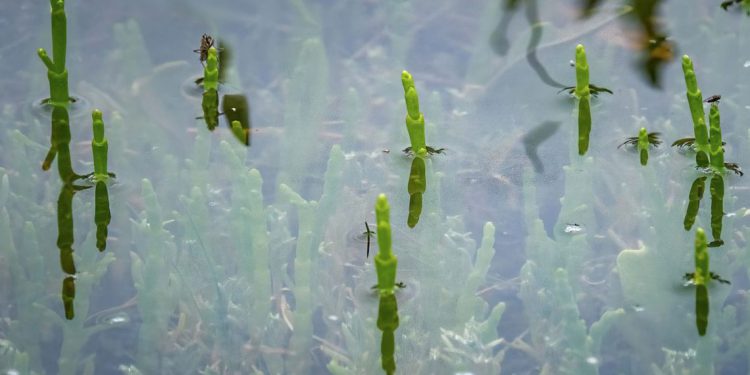England’s delectable, fleeting vegetable. The BBC says that one Norfolk speciality less familiar to visitors is a locally abundant wild plant that provides the perfect accompaniment to seafood. Samphire – or, as locals call it, “sam-fer”.
As well as being good to eat, samphire also has an important role to play in coastal ecology. In addition to providing valuable habitat for plants and birdlife, the tidal marshes on which it grows are important for protecting this fragile coastline from the storms and rising sea levels that cause serious erosion.
Marsh samphire can be found all around the British coast in suitable habitats, but many consider the most succulent is that which grows in the vast tidal mudflats of the north Norfolk coast.
Picked between June and August before it becomes woody, part of this locally abundant plant’s charm comes from its habit of growing in inaccessible places. It is a plant of the edge, of saltmarsh and creeks: that nebulous tidal zone where it is never quite clear where the land ends and the sea begins.
At its most palatable early in the season, the timing of its picking is crucial, not only of time of year but also of the sea itself, as the gathering of samphire necessitates a venture out into muddy creeks at low tide.
Samphire takes its name from a corruption of Saint Pierre (St Peter), the patron saint of fishermen.
According to plant expert Paul Simons in The Guardian, it has been demonstrated that saltmarshes absorb the power of waves far more effectively than manmade structures like sea walls. Marsh samphire is crucial in the formation of saltmarshes as its roots bind the mud to create a foothold for other salt-tolerant plants like sea aster and sea blite to grow.
Sometimes referred to as “poor man’s asparagus”, samphire, which although decidedly more salty, certainly has some of the qualities of that vegetable. Like asparagus, it is also an edible form of grass, although samphire has a singular briny quality all its own.
Its popularity as a vegetable has increased in recent years thanks to recognition by celebrity cooks like Hugh Fearnley-Whittingstall and Rick Stein, and samphire now appears regularly on the menus of many top London restaurants, which often obtain it from sources as far afield as Israel and Mexico that can provide a reliable, if expensive, year-round supply.
England’s delectable fleeting vegetable. More here…























